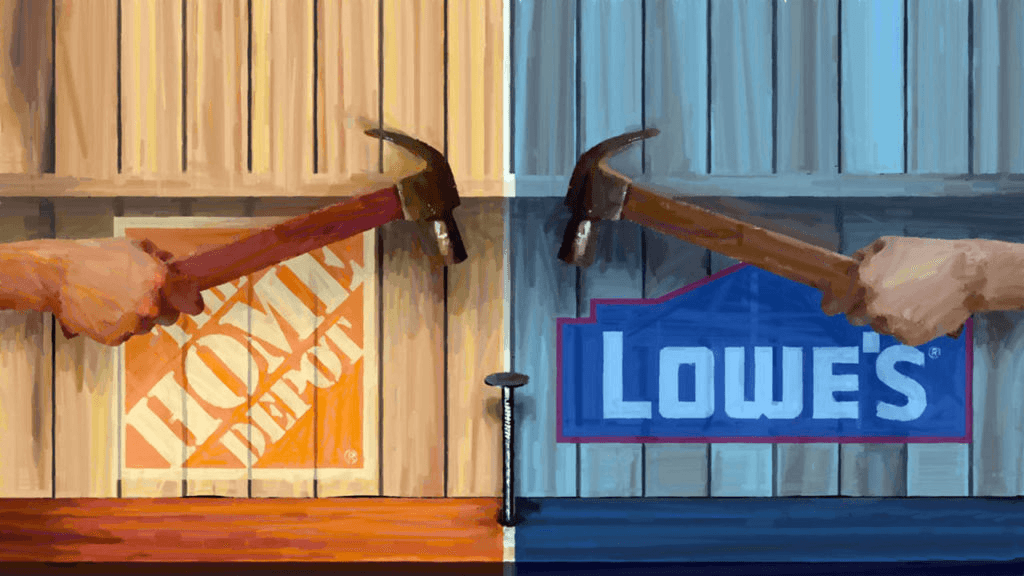Data Study: Home Depot vs. Lowe’s
January 8, 2021

Location intelligence allows companies to understand consumer behavior and get to know the real-world interests of their target audiences instead of relying on questions answered through a market research survey. For marketers charged with market research, they gain valuable insights not only into their customers but also the strategies that competitors are using to retain their customer base and conquer yours.
To shed some light on how location intelligence can be used for competitive insights, let’s take a look at two of the largest hardware and home goods retailers in the world: Lowe’s and Home Depot.

2020 Foot Traffic Data: Home Depot vs. Lowe’s
We all know that the lockdowns forced many retailers to temporarily shutdown their brick-and-mortar stores, especially if they were deemed nonessential. Lowe’s and Home Depot were allowed to remain open, but the disparities in foot-traffic numbers are profound.
Home Depot
When comparing the foot traffic data to February 2020’s numbers, April foot traffic was 15% lower. Foot traffic in May was 46% above pre-COVID levels. It began to recover in the summer months, but still remained below pre-pandemic levels. In July and August, foot traffic to Home Depot stores was 20% higher compared to February. In September, instead of the lack of recovery that we’ve seen in other industries, Home Depot’s numbers were 6% higher compared to February. As the holiday season began, November foot traffic to Home Depot stores was 5% lower than February 2020.
Lowe’s
Much like Home Depot, Lowe’s did see changes in foot traffic in April, though where Home Depot’s number was1 5% lower than February’s foot traffic data, Lowe’s was only 2% lower. We see the most drastic difference in May when foot traffic to Lowe’s was 62% higher than their February numbers. That number shifts significantly over the summer months. In June, foot traffic was 34% higher while July and August were 20% and 16% higher respectively compared to pre-COVID levels. Come October, foot traffic was 13% lower than February, and we see our first regression in foot traffic since April. The holiday season wasn’t as big foot traffic wise for Lowe’s. Foot traffic to Lowe’s stores in November was 16% lower compared to February 2020.
Will Home Depot Continue to Outperform Lowe’s?
One thing to note right off the bat is how consumers behaved during the lockdowns. What were their interests? With people cut off from social and outer distractions, their attentions turned inward, to their home surroundings. COVID-19 lockdowns brought out the DIY home improvement explorer in all of us as we attacked long-neglected home repairs and updates, or simply wanted to spruce up the area that we were stuck in for most of the day. Towards the beginning of the coronavirus pandemic, Lowe’s was outperforming Home Depot in terms of foot traffic. However, as fall and winter approached, Home Depot began to take a slight lead over Lowe’s. In 2021, both chains will need to focus their efforts on meeting customer expectations in order to drive in-store foot traffic.
Using Location Intelligence for Competitive Advantage
Location intelligence lets us truly understand consumer behavior – the places people visit, the stores they shop in, and what they do with their free time. We often talk about how this data can be used by advertisers to reach ideal consumers with Gravy Audiences. Yet, this is just the start.
For marketers charged with market research, location intelligence means access to behavioral information about your customers – and unprecedented insight into your competitors. Location data lets you better understand your current customers, and benchmark against your competitors in terms of customer profile, visit patterns, total foot traffic and more.
To illustrate the sort of competitive insights that brands can glean through location intelligence, Gravy’s team of data analysts decided to take a closer look at consumer visits to four major home improvement stores – Home Depot, Lowe’s, Ace Hardware and True Value.
Here’s a sample of what we found in our 2017 data study:
1. “Hey, Big Spender…”
Home Depot customers over-index for visits to places like yacht clubs and fine dining restaurants.
2. Relax and Enjoy the Journey
Lowe’s customers make the most of their shopping experience with the longest average time in store.
3. It’s a Beautiful Day in the Neighborhood
Truly a neighborhood store, customers of Ace Hardware travel the shortest distance to get there.
4. Nothing Ruins a Friday Like Realizing it’s Wednesday
True Value stores are busiest during weekdays – foot traffic drops by half on weekends.
5. Wish You Were Beer
Home improvement shoppers are 6x more likely to be Beer Lovers than the average consumer.
See how you could win new customers, improve competitive intelligence, and jumpstart loyalty programs with location data.




